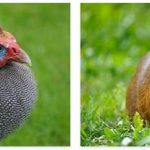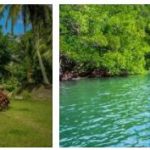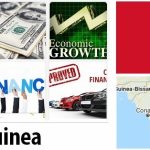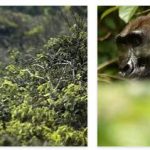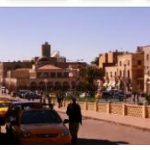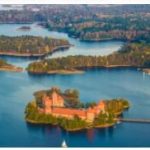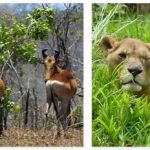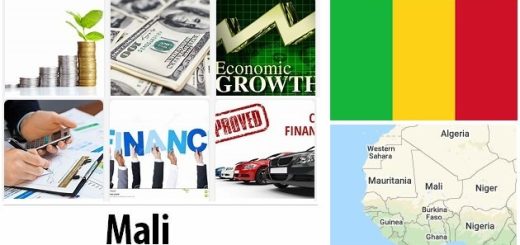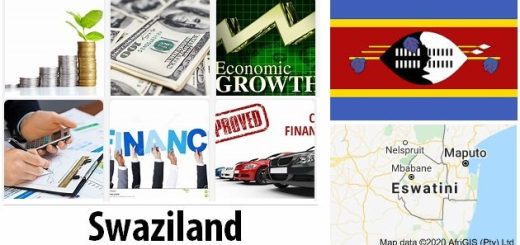Guinea-Bissau Overview
Animals and Plants
Which animals live in Guinea-Bissau?
Many animal species live in Guinea-Bissau. This also includes several monkeys such as the Guinea baboon, the green monkey, the West African colobus monkey, the Senegal galago, and the hussar monkey. The warthog is just as native here as the brush-eared pig and the aardvark. Aardvarks eat termites and live wherever they can be found. There are also cape buffalo and antelope such as the sitatunga.
Hyrax, porcupines, gray footed squirrels, Mozambique hares, pangolins, and several species of rats and mice also live across the country. The big cats in Guinea-Bissau include the caracal, wildcat, serval, spotted hyena and leopard. Have you ever heard of the leopard roller or the zebra mongoose? You live here too. Of the large mammal species, elephants and hippos can still be found in some protected areas.
Whales, dolphins and the African manatee live off the coast. There are also reptiles such as crocodiles, snakes and turtles.
Of course, a lot of birds also live in Guinea-Bissau. In addition to the fellows who flutter around here all year round, there are migratory birds from Europe that winter here. They belong to the larks (like the crested lark), swallows (like the house martin), bulbüls (like the graubülbül) or stilts (like the widow stilt).
The birds that live here all year round include, for example, the little grebe, the red-billed tropical bird, the great white pelican, the white-bellied gannet and the gray-headed parrot. Cormorants, darters, herons, storks, guinea fowl and flamingos are also at home in Guinea-Bissau.
And what is growing there in Guinea-Bissau?
Mangroves like the black mangrove grow on the coast of Guinea-Bissau. These trees like salty water and form swamps. They are joined by tropical rainforests.
In the savannah landscape inland, grassy areas alternate with forest. They form the Guinea Forest Savannah mosaic because from the air it looks like a mosaic. The trees include the African baobab tree, the tamarind tree, the mahogany species Khaya senegalensis.
For example, there are orchids in flowers. Annona senegalensis is a shrub. Carnivorous plants from the Utricularia family come in several species.
Economy
A poor country
Guinea-Bissau is one of the poorest countries in the world. 67 out of 100 people here live below the poverty line and have less than $ 1.90 a day to live on.
Corruption and bureaucracy are just as problematic for the development of the economy as the unstable political situation, drug trafficking or unpaved roads and power outages.
Guinea-Bissau’s economy is largely dependent on agriculture. 82 percent of the working population work in agriculture. But they only generate 50 percent of the state’s economic output. 13.1 percent of the revenue comes from industry. 36.9 percent come from services.
The cashew nut
However, many farmers only generate the bare minimum for themselves and small surpluses to sell on the market. Rice, corn, millet and cassava, the staple foods, are mainly grown.
For export, i.e. sales to other countries, the cashew nut plays the most important role. Cashew nuts account for 85 percent of export revenue. As a result, however, the dependency is also high: if the prices for cashew nuts fall, the farmers get too little money. But then they can no longer buy rice.
Cashew trees were planted in large plantations, the cultivation of rice or millet was neglected. Fish, shrimp, peanuts, palm kernel oil and wood are exported to a much lesser extent than cashew nuts.
The industry
There is hardly any industry in the country. Most of the existing establishments are active in food processing and beverages (sodas and beer). Mining could be expanded. In particular, Guinea-Bissau has deposits of phosphates and bauxite that could be mined. Oil and gold are also available.
Everyday Life
How do people live in Guinea-Bissau?
How do you live in Guinea-Bissau? The family plays a big role in everyone’s life. The actual relationship is not so important. A cousin can be like a sister. Since every woman has an average of five children, the families are already large. For more articles on Guinea-Bissau and Africa, please visit payhelpcenter.
No child in Guinea-Bissau owns a winter jacket or scarf. Why not? Because it’s always warm ! The people here have never seen snow. Most of the time the boys walk around in T-shirts and pants and the girls wear a skirt or dress. The women in Guinea-Bissau are also more likely to be seen in dresses than trousers. The clothes are colorfully patterned, and a matching scarf is often wrapped around the head. You buy fabrics for the clothes at the market and take them to a seamstress.
You get up early in the morning and start work. House and yard are swept. Anyone who has a field works there, and the children have to help too. Many children do not go to school and only help their parents or work elsewhere. Babies and toddlers are carried on the back. On the other hand, women in particular carry all loads on their heads, for example when they are selling something on the market. This is then packed into a large bowl or bowl and placed on top of the head on a folded towel.
Hardly anyone in the country has electricity. The power supply is better in the cities, but the electricity often fails. So electrical appliances are rarely used. Think about how many such devices are used in your home every day. Can you imagine living without electricity?
There are also some differences between those in the country and those in the city when it comes to residential buildings. Most of the houses in the city are made of stone. In the countryside, on the other hand, people live in round huts made of clay and covered with straw.
When you are out and about, you are mostly walking on unpaved roads. There are more of them in the city, but they often have potholes. If you want to go from the outskirts to the center or vice versa, take a Toka-Toka. That’s what the minibuses are called here.


